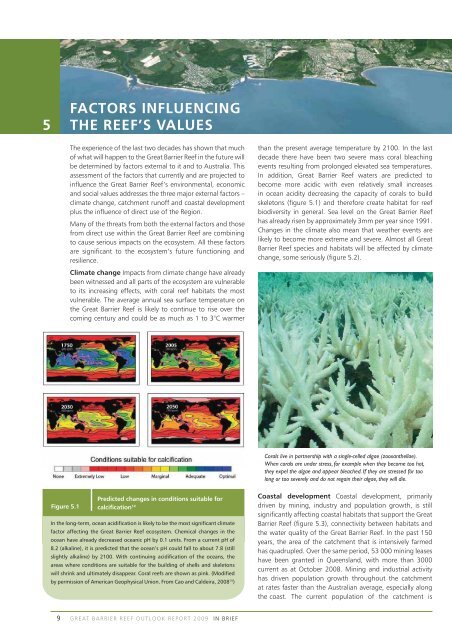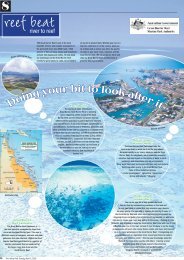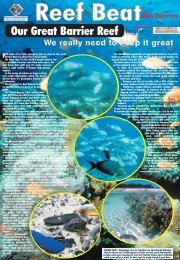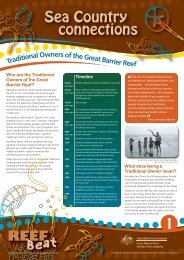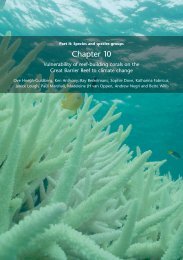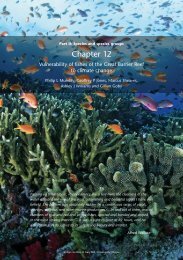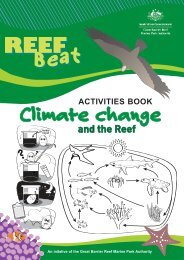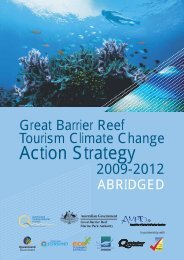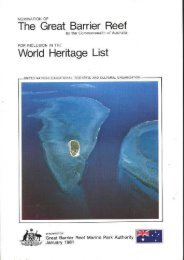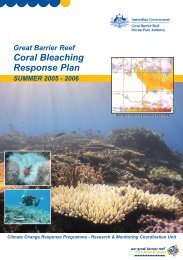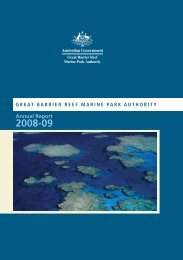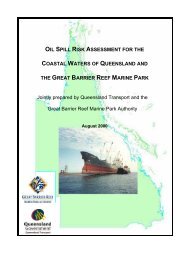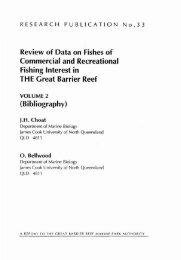Great Barrier Reef Outlook Report 2009 â In Brief
Great Barrier Reef Outlook Report 2009 â In Brief
Great Barrier Reef Outlook Report 2009 â In Brief
- No tags were found...
Create successful ePaper yourself
Turn your PDF publications into a flip-book with our unique Google optimized e-Paper software.
5FACTORS INFLUENCINGTHE REEF’S VALUESThe experience of the last two decades has shown that muchof what will happen to the <strong>Great</strong> <strong>Barrier</strong> <strong>Reef</strong> in the future willbe determined by factors external to it and to Australia. Thisassessment of the factors that currently and are projected toinfluence the <strong>Great</strong> <strong>Barrier</strong> <strong>Reef</strong>’s environmental, economicand social values addresses the three major external factors –climate change, catchment runoff and coastal developmentplus the influence of direct use of the Region.Many of the threats from both the external factors and thosefrom direct use within the <strong>Great</strong> <strong>Barrier</strong> <strong>Reef</strong> are combiningto cause serious impacts on the ecosystem. All these factorsare significant to the ecosystem’s future functioning andresilience.Climate change Impacts from climate change have alreadybeen witnessed and all parts of the ecosystem are vulnerableto its increasing effects, with coral reef habitats the mostvulnerable. The average annual sea surface temperature onthe <strong>Great</strong> <strong>Barrier</strong> <strong>Reef</strong> is likely to continue to rise over thecoming century and could be as much as 1 to 3°C warmerthan the present average temperature by 2100. <strong>In</strong> the lastdecade there have been two severe mass coral bleachingevents resulting from prolonged elevated sea temperatures.<strong>In</strong> addition, <strong>Great</strong> <strong>Barrier</strong> <strong>Reef</strong> waters are predicted tobecome more acidic with even relatively small increasesin ocean acidity decreasing the capacity of corals to buildskeletons (figure 5.1) and therefore create habitat for reefbiodiversity in general. Sea level on the <strong>Great</strong> <strong>Barrier</strong> <strong>Reef</strong>has already risen by approximately 3mm per year since 1991.Changes in the climate also mean that weather events arelikely to become more extreme and severe. Almost all <strong>Great</strong><strong>Barrier</strong> <strong>Reef</strong> species and habitats will be affected by climatechange, some seriously (figure 5.2).Corals live in partnership with a single-celled algae (zooxanthellae).When corals are under stress, for example when they become too hot,they expel the algae and appear bleached. If they are stressed for toolong or too severely and do not regain their algae, they will die.Figure 5.1Predicted changes in conditions suitable forcalcification 14<strong>In</strong> the long-term, ocean acidification is likely to be the most significant climatefactor affecting the <strong>Great</strong> <strong>Barrier</strong> <strong>Reef</strong> ecosystem. Chemical changes in theocean have already decreased oceanic pH by 0.1 units. From a current pH of8.2 (alkaline), it is predicted that the ocean’s pH could fall to about 7.8 (stillslightly alkaline) by 2100. With continuing acidification of the oceans, theareas where conditions are suitable for the building of shells and skeletonswill shrink and ultimately disappear. Coral reefs are shown as pink. (Modifiedby permission of American Geophysical Union. From Cao and Caldeira, 2008 15 )Coastal development Coastal development, primarilydriven by mining, industry and population growth, is stillsignificantly affecting coastal habitats that support the <strong>Great</strong><strong>Barrier</strong> <strong>Reef</strong> (figure 5.3), connectivity between habitats andthe water quality of the <strong>Great</strong> <strong>Barrier</strong> <strong>Reef</strong>. <strong>In</strong> the past 150years, the area of the catchment that is intensively farmedhas quadrupled. Over the same period, 53 000 mining leaseshave been granted in Queensland, with more than 3000current as at October 2008. Mining and industrial activityhas driven population growth throughout the catchmentat rates faster than the Australian average, especially alongthe coast. The current population of the catchment is9GREAT BARRIER REEF OUTLOOK REPORT <strong>2009</strong> IN BRIEF


